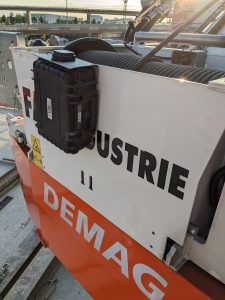A look back at the RTK.42 solution used on the construction site of the Orly airport station to ensure the safety of lifting equipment in coactivity.
Anti-collision between Mobile Cranes and Tower Cranes
One to two mobile cranes are permanently present on the site.
Cranes can work from a few days to a few months on the construction site. The flexibility as well as the speed of installation and uninstallation on any crane was essential in choosing the solution to be implemented.
When two cranes approach in a dangerous way, the tablet which equips the cabin of the crane driver warns him of the danger by an audible and luminous signal. Ascorel's MC603 interference management system on the tower crane integrates mobile cranes equipped with RTK.42 (CAD.42 system) as luffing jib cranes into the interference management system.

Compatible with all mobile cranes
In our Unifield application, the type of mobile crane is easily configurable to manage all possible mobile cranes: ppm, lattice, MK88… On this site, PPM and MK88 type cranes succeeded each other throughout the 8 months of use of the system.


GM Crane Tablet

Sensor on the GM counterweight type PPM or on the barrel of the MK

Sensor on the arrow head of the PPM or on the block of the MK
Florent PERRIN, prevention manager of the project for DEMATHIEU BARD :
“We used the Cad.42 anti-collision assistance system for 8 months on the Orly Station and Silo Parking site. In fact, the space and time constraints of the construction site require us to use one or two additional mobile cranes in the interference zone of our tower crane. The ease of installation of the RTK.42 boxes was able to meet our expectations of speed and efficiency regarding the risk of collision between the different cranes used on the site, the system is a real prevention tool for crane operators (crane tower + mobile cranes). “

